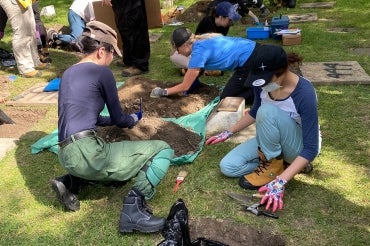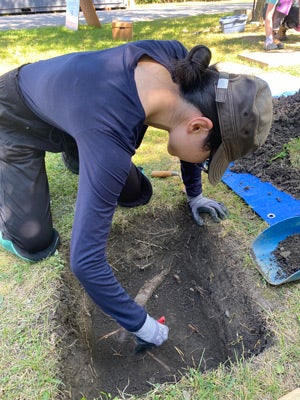U of T Mississauga forensic students help prepare pet cemetery for relocation

Students in U of T Mississauga's forensics program carefully dig up and catalogue animal remains from the Oakville and Milton Humane Society pet cemetery, preparing it for eventual relocation (photos by Tracy Rogers)
Published: October 12, 2023
Forensic anthropology students at the University of Toronto Mississauga have been offered an unusual opportunity to gain hands-on experience.
For the next 18 months, 60 undergraduate and graduate students will help dig up and catalogue animal remains at the Oakville and Milton Humane Society (OMHS) pet cemetery.
The task involves more than 500 graves in a cemetery that was active from 1953 to 1991.
“We have had students working cadaver dogs, developing or adjusting fingerprinting techniques, analyzing bullet trajectories – but nothing quite like this cemetery,” says Grace Gregory-Alcock, a PhD student who is supervising the excavation.
“It’s one of the largest projects the field school course has ever undertaken.”
She says the humane society decided it needed to relocate in pursuit of more space and reached out to Professor Tracy Rogers, director of the forensic science program, to get a better sense of their options for the cemetery.
“When they found out what could happen to the cemetery if it were left – essentially anything, as it is not protected under any laws – they did not want that, so they asked for her help in recovering the remains and preserving them.”

The work is a class component for those enrolled in U of T Mississauga’s forensic anthropology field school (ANT306) and advanced bioarcheology (ANT441), which teaches methods of analysis, theoretical issues and the excavation, documentation and interpretation of a burial.
Gregory-Alcock says the experience will help students develop skills in: documentation, as they fill in official forms to document each grave; communications, to explain what they are seeing in the soil and to indicate what they need from their partner or teaching assistant; excavation, as they trowel and remove soil, and identify changes in the soil texture/content; and recovery skills, such as how to properly remove the remains from the ground – all at once or systematically.
“Our priority is to ensure the proper documentation and excavation of the graves, in order to recover the pets as carefully and respectfully as possible,” Rogers, who is also a consultant to the Ontario Forensic Pathology Service, said in a news release. “This important community project will provide students with a unique opportunity to develop practical skills, while helping them understand why care and consideration of those we recover from any context (historic, modern, or forensic) is so important to the families who love them.”
The OMHS, a non-profit organization dedicated to the protection and well-being of animals in the Oakville and Milton communities, has been contacting former owners to inform them of the cemetery’s relocation.
"We are dedicated to providing the utmost care of these beloved pets and are grateful for the expertise that Dr. Rogers and her team bring to this important project,” said OMHS Executive Director Jeff Vallentin in a statement.
Each lot, which contains remains varying in size from small family pets to a racehorse named St. Ina, will be documented with photos and notes and be housed in a secure facility at the current OMHS location until a new location can be found.



